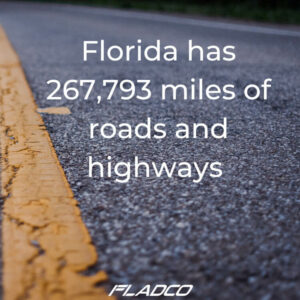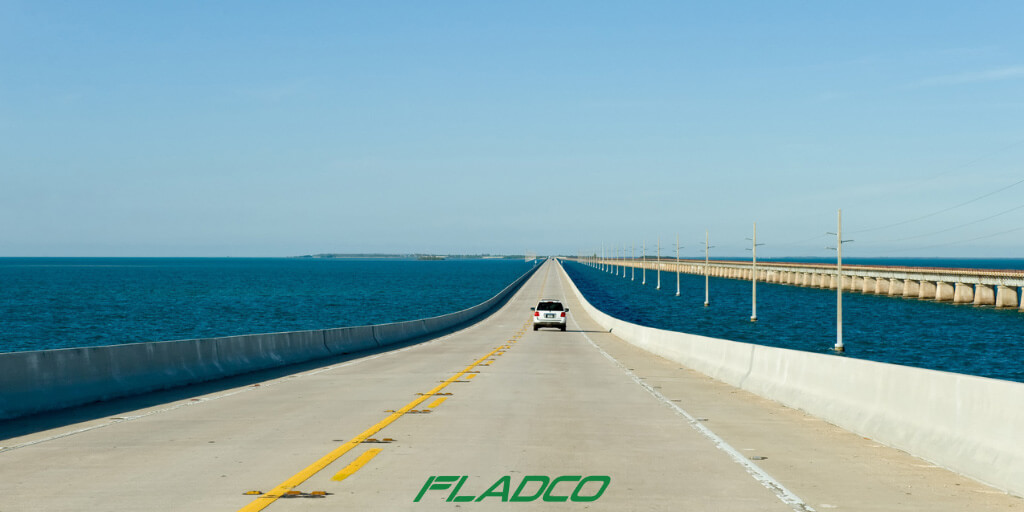Before the rise and availability of automotive transportation, the Sunshine State of Florida consisted of swamp lands, palm trees, and sandy beaches. Now, highway systems connect every gator, key lime pie, and orange grove in the state to all major cities.
Access to the entire state began in 1912, when millionaire Henry Flagler built the Florida Keys Over-Sea Railroad from Miami to Key West. The train route was meant to bring mainland Florida to the varied and aesthetic vacation spots that line our coast. At the time, Florida barely had dirt trails and horse paths for travel. During the state’s rainy season, it wasn’t uncommon for these trails to flood and turn impassable.
President Woodrow Wilson took notice. In 1916, Wilson signed the Federal Aid Road Act that directed funds for joint Federal and State road construction. In response, Florida established the State Road Department and went to work.
The First Roads in Florida
The first Florida roads were made of rocks, gravel, and cement. This may have been crude by modern standards, but it blew Floridians’ minds, connecting communities that were totally isolated via lane roads maintained locally. To promote the work, the organization published the monthly magazine Florida Highways. The Library of Florida History collected each of these editions from January 1925-1953.
By the next decade’s census, a majority of Florida’s population lived outside the panhandle. In response, construction began on the Tamiami Trail, a highway that cut through the Everglades, connecting Miami to Tampa.
Around 1921, Florida first assigned numbers to its state roads. Every two years, the local legislature met to plan out new routes. It took another two decades before this antiquated system was replaced by the modern grid system. Only a few vestiges of the numbering system remain in the Sunshine State, including Volusia County Road 3.
The Overseas Highway and Other Florida Highway Projects
The Overseas Highway is often called “The Highway That Goes To Sea. The southernmost leg of U.S. Highway 1 stretches 113 miles from Key Largo to Key West. In 1935, a hurricane damaged Flagler’s original railroad system. Three years later, it was completely replaced by the Overseas Highway, utilizing the foundation that incorporated the rail tracks. The road incorporates an incredible 42 bridges in a series of giant arches of concrete and steel over the Atlantic Ocean, Florida Bay, and Gulf of Mexico. In 2009, the Keys highway was designated as our state’s first and only All-American Road by the US Federal Highway Administration.
The early ‘20s identified many of the roads throughout the area as “State Roads,” or those that are designated by the legislature in accordance with the law that will continue to receive construction, maintenance, or improvements by the State Road Department. By 1923, 540 roads received this designation.
In the decades that followed, road projects included U.S. Route 1, U.S. Route 41, and State Road A1A. Each gave complete access to the state’s major population and industrial centers.
Following the Great Depression, roads were divided into four classes. These included primary (arterial highways and other primary roads) and secondary (county roads), state parks, county, and city streets. If a secondary increased in importance, it was elevated to the primary system, and vice versa.
 Post-WWII Florida Roads and Highways
Post-WWII Florida Roads and Highways
In the ‘70s, a transportation policy act eliminated the secondary roads. The divisions changed to state, county, and local. Secondary and a few primary stretches were given over to the counties; some main roads in incorporated areas were given to localities.
A dozen major highways join together the Sunshine State. U.S. Highway 1 is the biggest, entering the state at Jacksonville and leading to Canada, the highway passes through most of the eastern coastal communities.
Before Walt Disney founded Disney World, and Orlando became the capital of theme parks, the roads that crisscrossed through the central part of the state were two-lane blacktops. Once the House of Mouse opened its doors, Interstate Highway 4 connected Daytona Beach to Tampa Bay, moving through the heart of the city and allowing access to the Orlando International Airport. It is widely considered the busiest in the state. The I-4 intersects the I-75 outside of Tampa and the I-95 near Daytona Beach. It also has access to the very popular Busch Gardens.
In comparison, the I-75 is the longest in the state. The highway begins in Miami and travels west through the Everglades, ultimately ending up in the city of Naples on the west coach. Other cities on the highway include Fort Myers, Tampa, Ocala, Gainesville, Lake City, and northern access into the state of Georgia.
Road segments that are discontinuous must contain a logical and sequential connection that is shared between them. State road numbers are all assigned by FDOT. All state roads have a number. All roads leading from north to south bear odds numbers with the number 1 assigned to the most easterly road. All roads going from east to west have even numbers with the number 2 assigned to the most northerly road. Main connecting roads are assigned two-digit numbers between the limiting control routes.
When roadways began, Florida had a population of fewer than two million residents. Now, Florida has 21.5 million residents, with countless visitors through our border each year. The Florida Highway Patrol monitors these roads with a total of 2,496 full-time employees, patrolling over two million miles of roadway. Today, Florida has over 3,442 miles of interstate and over 267,793 combined miles of roads and highways.




